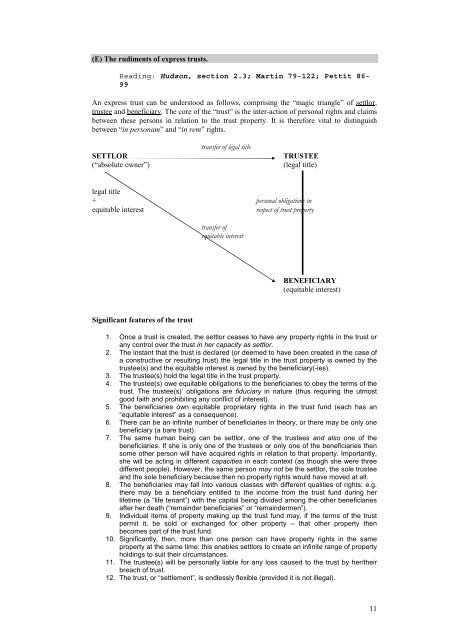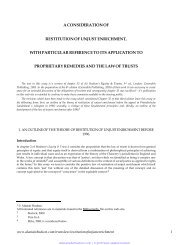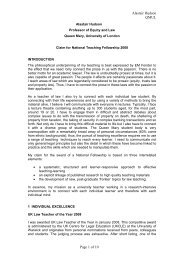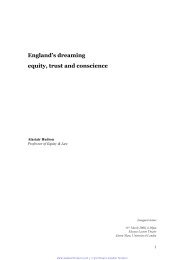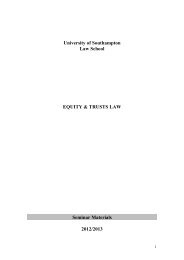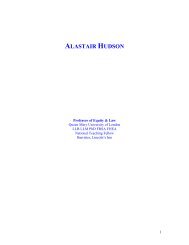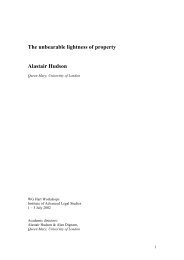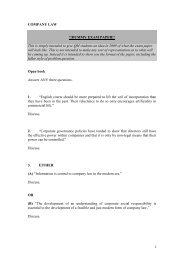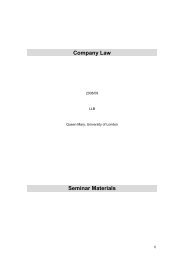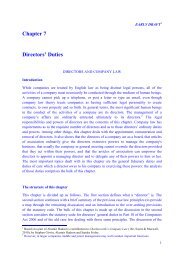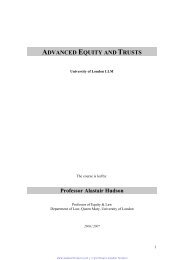Soton Equity and Trusts - alastairhudson.com
Soton Equity and Trusts - alastairhudson.com
Soton Equity and Trusts - alastairhudson.com
Create successful ePaper yourself
Turn your PDF publications into a flip-book with our unique Google optimized e-Paper software.
(E) The rudiments of express trusts.<br />
Reading: Hudson, section 2.3; Martin 79-122; Pettit 86-<br />
99<br />
An express trust can be understood as follows, <strong>com</strong>prising the “magic triangle” of settlor,<br />
trustee <strong>and</strong> beneficiary. The core of the “trust” is the inter-action of personal rights <strong>and</strong> claims<br />
between these persons in relation to the trust property. It is therefore vital to distinguish<br />
between “in personam” <strong>and</strong> “in rem” rights.<br />
SETTLOR<br />
(“absolute owner”)<br />
transfer of legal title<br />
TRUSTEE<br />
(legal title)<br />
legal title<br />
+ personal obligations in<br />
equitable interest<br />
respect of trust property<br />
transfer of<br />
equitable interest<br />
BENEFICIARY<br />
(equitable interest)<br />
Significant features of the trust<br />
1. Once a trust is created, the settlor ceases to have any property rights in the trust or<br />
any control over the trust in her capacity as settlor.<br />
2. The instant that the trust is declared (or deemed to have been created in the case of<br />
a constructive or resulting trust) the legal title in the trust property is owned by the<br />
trustee(s) <strong>and</strong> the equitable interest is owned by the beneficiary(-ies).<br />
3. The trustee(s) hold the legal title in the trust property.<br />
4. The trustee(s) owe equitable obligations to the beneficiaries to obey the terms of the<br />
trust. The trustee(s)’ obligations are fiduciary in nature (thus requiring the utmost<br />
good faith <strong>and</strong> prohibiting any conflict of interest).<br />
5. The beneficiaries own equitable proprietary rights in the trust fund (each has an<br />
“equitable interest” as a consequence).<br />
6. There can be an infinite number of beneficiaries in theory, or there may be only one<br />
beneficiary (a bare trust).<br />
7. The same human being can be settlor, one of the trustees <strong>and</strong> also one of the<br />
beneficiaries. If she is only one of the trustees or only one of the beneficiaries then<br />
some other person will have acquired rights in relation to that property. Importantly,<br />
she will be acting in different capacities in each context (as though she were three<br />
different people). However, the same person may not be the settlor, the sole trustee<br />
<strong>and</strong> the sole beneficiary because then no property rights would have moved at all.<br />
8. The beneficiaries may fall into various classes with different qualities of rights: e.g.<br />
there may be a beneficiary entitled to the in<strong>com</strong>e from the trust fund during her<br />
lifetime (a “life tenant”) with the capital being divided among the other beneficiaries<br />
after her death (“remainder beneficiaries” or “remaindermen”).<br />
9. Individual items of property making up the trust fund may, if the terms of the trust<br />
permit it, be sold or exchanged for other property – that other property then<br />
be<strong>com</strong>es part of the trust fund.<br />
10. Significantly, then, more than one person can have property rights in the same<br />
property at the same time: this enables settlors to create an infinite range of property<br />
holdings to suit their circumstances.<br />
11. The trustee(s) will be personally liable for any loss caused to the trust by her/their<br />
breach of trust.<br />
12. The trust, or “settlement”, is endlessly flexible (provided it is not illegal).<br />
11


